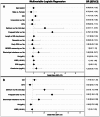Factors associated with hospitalization from a geriatric short-stay unit (OBI-GER): a retrospective cohort study
- PMID: 40711669
- PMCID: PMC12296983
- DOI: 10.1007/s40520-025-03125-1
Factors associated with hospitalization from a geriatric short-stay unit (OBI-GER): a retrospective cohort study
Abstract
Background: Geriatric Short-Stay Observation Units (G-SSU) are specialized units designed to improve care for older adults within the emergency department (ED). At our hospital, the Osservazione Breve Intensiva Geriatrica (OBI-GER) was established as a dedicated G-SSU.
Aims: This study aims to characterize the clinical profile of older adults admitted to OBI-GER and identify factors associated with hospitalization within the first 24 h of admission.
Methods: Retrospective, single-center study including individuals aged ≥ 75 years, admitted to OBI-GER between August 2023 and August 2024, with frailty and/or delirium during ED stay. Multivariable logistic regression model with stepwise selection was used to assess associations between hospitalization and clinical, functional, laboratory, and organizational variables.
Results: Overall, 353 patients (mean age 86.8 ± 5.5 years, 47.9% male) were included, of whom 109 (30.8%) required hospitalization. The cohort exhibited moderate frailty (median Clinical Frailty Scale = 6, IQR 6-7) and a considerable comorbidity burden (median Charlson Comorbidity Index [CCI] = 6, IQR 5-8), along with a high prevalence of dementia (45%) and polypharmacy (mean 7.1 ± 3.4 medications). Independent risk factors for hospitalization included higher CCI (OR 1.19, 95% CI 1.05-1.35), delirium on the first day of OBI-GER (OR 2.03, 95% CI 1.13-3.64), frequent faller profile (OR 2.66; 95% CI 1.38-5.12), and lower hemoglobin levels at ED admission (OR 0.89, 95% CI 0.79-0.99).
Conclusions: Despite their clinical complexity, only one-third of patients admitted to OBI-GER required hospitalization. CCI, delirium, fall history, and hemoglobin levels may serve to stratify hospitalization risk and optimize patient selection for G-SSU.
Keywords: Comprehensive geriatric assessment; Frailty; Geriatric emergency medicine; Older adults; Short-stay unit.
© 2025. The Author(s).
Conflict of interest statement
Declarations. Ethics approval: This study was performed in line with the principles of the Declaration of Helsinki. The local Ethics Committee (deliberation no. 1205, December 14, 2022) authorized data collection and its use as part of a clinical registry. Informed consent: Informed consent was obtained from all individual participants or their next of kin when patients were not able to provide consent. Conflict of interest: The authors have no competing interests to declare that are relevant to the content of this article.
Figures



Similar articles
-
Frailty Could Predict Death in Older Adults after Admissionat Emergency Department? A 6-month Prospective Study from a Middle-Income Country.J Nutr Health Aging. 2019;23(7):641-647. doi: 10.1007/s12603-019-1207-9. J Nutr Health Aging. 2019. PMID: 31367729 Free PMC article.
-
Exercise for acutely hospitalised older medical patients.Cochrane Database Syst Rev. 2022 Nov 10;11(11):CD005955. doi: 10.1002/14651858.CD005955.pub3. Cochrane Database Syst Rev. 2022. PMID: 36355032 Free PMC article.
-
Frailty index predicts adverse short- and long-term outcomes in older adults with rib fractures.Injury. 2025 May;56(5):112144. doi: 10.1016/j.injury.2025.112144. Epub 2025 Jan 5. Injury. 2025. PMID: 39800638
-
Remote Patient Monitoring System for Polypathological Older Adults at High Risk for Hospitalization: Retrospective Cohort Study.J Med Internet Res. 2025 Jul 14;27:e71527. doi: 10.2196/71527. J Med Internet Res. 2025. PMID: 40658993 Free PMC article.
-
Comprehensive Geriatric Assessment for community-dwelling, high-risk, frail, older people.Cochrane Database Syst Rev. 2022 May 6;5(5):CD012705. doi: 10.1002/14651858.CD012705.pub2. Cochrane Database Syst Rev. 2022. PMID: 35521829 Free PMC article.
References
-
- Bo M, Bonetto M, Bottignole G et al (2016) Length of stay in the emergency department and occurrence of delirium in older medical patients. J Am Geriatr Soc 64:1114–1119 - PubMed
-
- Sison SDM, Kim DH (2024) Rethinking emergency care for older adults living with frailty. Lancet Healthy Longev; 5 - PubMed
MeSH terms
LinkOut - more resources
Full Text Sources

